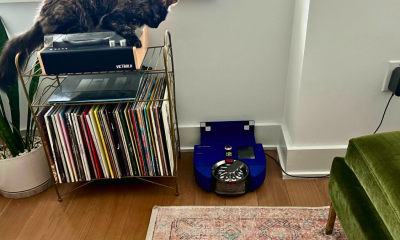Technology
Startups want to solve clothing fit with tech


Naked Labs can give a detailed breakdown of a user’s
health statistics, but it could also have big implications for
retailers.
Naked
Labs
-
One of the biggest drawbacks of shopping for clothes
online is not being able to try things on before buying
them. -
To solve that problem, startups are looking for ways to
incorporate 3D body-scanning technology and augmented
reality into the shopping experience. -
This could ultimately come at the expense of
traditional brick-and-mortar stores.
One of the biggest advantages of shopping for clothing online —
not having to try things on — is also one of its biggest
drawbacks. Without having seen clothing items in person
beforehand, it can be difficult to know whether they will fit
properly.
Now several tech startups are locked in a race to create new
technology that could change that.
California-based startup Naked Labs is one of them.
It recently unveiled
a 3D body-scanning mirror with a connected
rotating scale that sends detailed information about
your health, weight, body mass index, and body measurements to
the connected mobile app.
While the technology is currently targeted at the world of
fitness, its uses are limitless,
co-founder Ed Sclater told Business Insider’s Zoë
Bernard in July.
In fact, it’s already looking at ways to partner with
fashion retailers to create an online world where you can
virtually shop for outfits fitted precisely to your
measurements.

Naked Labs’ smart mirror.
Naked Labs
“Our biggest problem is figuring out what not to do,”
Sclater said. “We have opportunities in the gym space, the
medical space, the insurance space, where companies are moving
from reactive to proactive care. We’re interested in working with
anyone who wants to customize the world for your body.”
Amazon, which is making big moves to grow its own apparel
empire,
bought
New York-based startup Body Labs, a company
that makes software that captures the body’s shape and
motion in three dimensions, in October.
In May,
The Wall Street Journal reported that Amazon was
inviting people to a New York office to have the shape and size
of their
bodies scanned over the course of 20
weeks. It could conceivably be creating a
system for customers to virtually try on clothes or shop for
styles that are better fitted to their body shape. An Amazon
spokesperson declined to comment on the speculation to Business
Insider.
Transforming e-commerce for the better
While Amazon has
proven that we don’t need to visit a store to pick up books,
household goods, or even electronics, clothing shopping can be a
little less straightforward.
Online fashion stores such as Asos have
tried to overcome this issue by offering free returns. Amazon has
even launched
a service, called Prime Wardrobe, that mimics the
fitting-room experience by shipping customers items and letting
them return any that they don’t want before their credit card is
charged.
Essentially all that’s missing is a technology that would allow
shoppers to virtually try on the clothing at home.
These technologies would not only transform the way that we shop
online but would also solve one of e-commerce’s biggest issues:
excessive returns. According to
Coresight Research, around 30-40% of clothing ordered
online is returned. That figure jumps to 50% for dresses
alone.
“It’s a $300 billion problem, which eats into
the margins and bottom lines,” Maya Mikhailov, chief
marketing officer of GPShopper, a mobile retail app developer
that looks at ways to drive customer engagement, told Business
Insider.
“Artificial intelligence combined with augmented
reality are two of the most exciting concepts
going on in retail right now. They are leading to true
personalization,” she said.
This new technology could come at the expense of traditional
brick-and-mortar stores, many of which are clinging to the idea
that customers who are dissatisfied by ill-fitting clothes bought
online end up heading to stores.
“If 3-D body scanning came into greater use it would give
consumers more confidence in shopping online and would
potentially undermine one of the benefits of physical shopping,”
Neil Saunders, managing director of GlobalData Retail, wrote
in a comment emailed to Business Insider.
However, Mikhailov said that brick-and-mortar stores
can also use this technology to their own advantage by allowing
customers to try on clothing at home before they even walk into
the store. That way, the customer could end up being more
comfortable about making purchasing decisions in-store, possibly
even buying more than they had planned.
“How many of us have been in a fitting room where you go
through 10 to 12 pairs of jeans and you are feeling
miserable — maybe if you can try on sizes
before, you can limit it down to three pairs before
you go in and feel better about yourself in the store,” she
said.
It’s about understanding the consumer’s preferences versus
thrusting the retailer’s preferences on them, she said,
adding:
“Wherever you want to shop, we want to
be there.”
-

 Business5 days ago
Business5 days agoAPI startup Noname Security nears $500M deal to sell itself to Akamai
-

 Business6 days ago
Business6 days agoUS think tank Heritage Foundation hit by cyberattack
-

 Entertainment5 days ago
Entertainment5 days agoNASA discovered bacteria that wouldn’t die. Now it’s boosting sunscreen.
-

 Entertainment5 days ago
Entertainment5 days agoHow to watch ‘Argylle’: When and where is it streaming?
-

 Business4 days ago
Business4 days agoTesla drops prices, Meta confirms Llama 3 release, and Apple allows emulators in the App Store
-

 Entertainment4 days ago
Entertainment4 days ago‘The Sympathizer’ review: Park Chan-wook’s Vietnam War spy thriller is TV magic
-

 Business3 days ago
Business3 days agoTechCrunch Mobility: Cruise robotaxis return and Ford’s BlueCruise comes under scrutiny
-

 Entertainment5 days ago
Entertainment5 days agoDyson 360 Vis Nav robot vacuum review: Dyson should just stick to upright vacuums




















